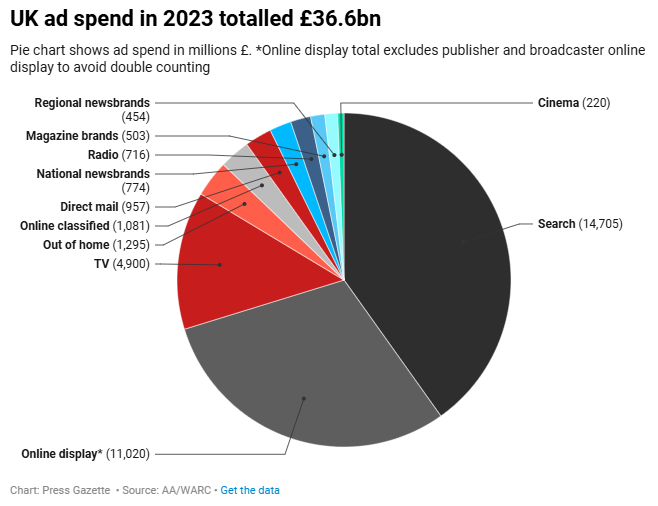
2024-8-30 17:14:51 Author: securityboulevard.com(查看原文) 阅读量:2 收藏
How Google Addresses Click Fraud
Click fraud is a big problem for Google, because if companies notice that a substantial portion of their Google Ads budget is wasted on fraudulent clicks, they may decide to advertise elsewhere. Google may be the biggest search engine, but companies still have many other ways they can advertise, from ads on social media platforms to physical advertising.

Search may be the biggest source of ad spend in most countries, but there are many other avenues too
So it’s in Google’s best interests to protect their Google Ads from click fraud. To begin with, it’s important to note that you will not be not charged for any invalid traffic that Google discovers. If Google notices click fraud after the associated money has been deducted from your account, they will simply credit it back in the form of “invalid traffic credits.”
Google has a multi-layered approach to stopping click fraud: It has an automated system that uses Google’s algorithms to detect and filter out invalid clicks on Google Ads in real-time. These algorithms are designed to distinguish between genuine interactions and fraudulent ones. If that doesn’t suffice, Google also has a team of experts that are continuously searching for potentially invalid traffic.
More specifically, Google relies on several data points to figure out what’s invalid traffic and what’s not:
- IP addresses: Identifies repeated interactions from the same IP address.
- Interaction times: Tracks the timing and frequency of clicks.
- Duplicate interactions: Detects and filters out multiple clicks from the same source.
Additionally, Google offers companies the ability to request an invalid traffic investigation if they still believe there’s click fraud on their ads.
How to Identify Google Ads Click Fraud
But Google is predominantly a search engine. It’s not a cybersecurity company. Despite Google’s best attempts, companies still struggle with click fraud on Google Ads. That’s why it makes sense to understand what signs indicate click fraud, so you can proactively protect your Google Ads campaigns.
Monitor your campaign metrics: This is a best practice regardless of click fraud. You should always keep a close eye on key advertising metrics such as CTR and conversion rates. Click-through rates that spike but don’t lead to a corresponding increase in conversions can be a sign of fraudulent activity.
Examine IP addresses: There’s a reason Google looks at IP addresses to identify invalid traffic. Because multiple clicks coming from the same IP address within a short period can be an indicator of fraudulent behavior. Just be aware that legitimate users sometimes share the same IP, so consider it alongside other factors.
Analyze your bounce rates and engagement rates: High bounce rates and low engagement rates can also be indicators of click fraud, especially if they’re out of line with your usual bounce rates and engagement rates. If users are clicking on your ads, but immediately leaving your website without doing anything else, it may suggest that traffic isn’t genuine.
Cross-reference Google Ads data: If there’s a difference between the number of clicks reported by Google Ads and the actual visits recorded in Google Analytics (or whatever web analytics service you use), it’s another reliable indicator of fraudulent activity. If you notice more clicks than visits or conversions, you may want to investigate further.
How to Prevent Google Ads Click Fraud
While Google does a reasonable job filtering out most invalid traffic, fraudsters also don’t rest on their laurels. They’re always looking for new ways to punch through Google’s defenses. That’s why, to begin with, you should conduct regular audits of your ad traffic and adjust your targeting settings to minimize exposure to high-risk areas or countries you don’t do business in.
Additionally, as suggested by this Redditor, you can reduce click fraud by limiting your campaigns to Google’s Search Network. Don’t use their Display Network. And if you really want to use the Display Network too (which is understandable given its size), use a different landing page for it and add a CAPTCHA. You will also have less click fraud if you stay away from Performance Max (PMAX) campaigns and stick to Exact and Phrase Match campaigns.
But your best line of defense, one that will protect you against all types of click fraud, is an automated click fraud solution. Ideally created by a company focused entirely on detecting and preventing malicious bot traffic. Software that can immediately detect automated clicks on your ads and filter them out before they can do any damage.
That’s what DataDome Ad Protect does. It uses multi-layered machine learning techniques to analyze five trillion signals every day, to protect your advertising campaigns from click fraud. Integrating the software can be done both on client- and server-side without having to adjust your existing tech stack. DataDome Ad Protect has unparalleled accuracy and takes only a few minutes to set up. It’s the fastest and easiest way to prevent click fraud.
No More Click Fraud
Click fraud is a persistent and evolving challenge for digital advertisers, especially on platforms as large and influential as Google Ads. While Google has implemented robust measures to combat fraudulent activity, the sophistication of click fraudsters means that businesses cannot rely on Google’s defenses alone.
By understanding the signs of click fraud, regularly auditing ad traffic, limiting your campaigns to Google’s Search Network, and employing advanced PPC protection solutions like DataDome Ad Protect, companies can protect their advertising budgets and ensure that their campaigns are reaching genuine audiences. When every click counts, proactive protection against click fraud is what will get the best use out of your advertising budget.
如有侵权请联系:admin#unsafe.sh